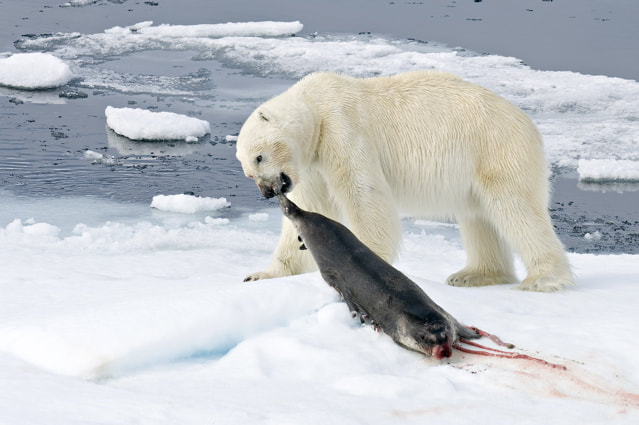|
Our world is cascading under food crunch and animals and birds are no exclusions to this. A new study has found that wild polar bears have increased metabolic rates than before, and drastic climatic and environmental changes affect food sources of these white fuzzy creatures-they are less able to catch enough prey to meet their energy needs than before.
Polar Bears with Collar Trackers Nine female polar bears were made to wear high-tech collars that recorded video, location and activity levels for some 8-12 days while metabolic tracers tracked the bear’s energy expenditure. Surprisingly, the metabolic rates were almost up by 50% than previously predicted and five of the nine bears lost body mass. These facts without doubt convey the message that polar bears were unable to catch the required quantity of prey to match their energy requirements. The research group also found that these white-haired creatures have higher metabolic rates than earlier thought. On analyzing, they feel that these bears are subjected to long-distance travels to hunt down their prey because of the Arctic sea-ice which makes it difficult for them to catch their prey. Generally, polar bears use the sea ice to hunt seals and decrease in frozen ice in the Arctic (decline of about 14% per decade) makes these bears look for their food farther away. It is before the summer that decides how much of fat they can accumulate onto their body and how much of energy stores they have that can be expended. Before this study, researchers assumed that polar bears used less energy as they are mostly ‘sit-and-wait’ creatures that would minimize their energy expenditure while hunting. All these were disproved with the results from the high-tech collars that showed that they need higher energy and they must be catching more seals than expected. The Declining Rates Polar bear population has been steadily decreasing by about 40 percent over the past decade. With the latest technological advancements, it makes it explicit for researchers to understand the way these bears move on ice, their activity patterns and energy needs. All these make it easier to comprehend the effect of these changes in the sea-ice. Global warming and environmental changes are affecting creatures living worldwide in some way. Carbon footprints differ for different foods that again affect the environment in different ways. Individuals interested in reducing carbon footprints and enhancing environmentalism can visit the website www.firsteatright.com. We, as humans are blessed with the sixth sense that helps us differentiate the good from the bad. If we don’t take charge of things at least in this juncture and try to sort them out, we would be self-destructing our own planet and the days are not far off for this final event of the human ecosystem. Comments are closed.
|
AVOID FRAUD. EAT SMART.+91 7846 800 800
AuthorDietitian & Nutritionist Dr. Nafeesa Imteyaz. Archives
November 2022
Categories
All
Dr. Nafeesa's Blog @blogspot |
- Home
- Written Testimonials
- Consult
- Clinics
- Blogs
-
Diet & Nutrition
- Diabetes Reversal
- IVF IUI not needed for PCOS PCOD Infertility
-
Medical Nutrition
>
-
Disease & Conditions
>
- Infertility | PCOS
- Diabetes Mellitus
- Cholesterol
- Hypothyroid
- Kidney Problems
- Hypertension
- Cardiovascular Diseases
- Liver Diseases
- Gastro intestinal disorder
- Cancer
- Metabolic Disorders
- Orthopedic Disorders
- Eating Disorders
- Dietary Recall
- Weight Record Filled By Clients
- Online Payment Transaction Details
- Online Clients Weight Check Form
- Our Program Package Service Charges
- Weight Record 2017 Clients
- Measurements sent by Clients
- Terms & Conditions Of Payment
- Thanks. Your Form is Submitted
- Video Testimonials
- Lifestyle & Wellness
- Lifestyle & Wellness Blog
- Allergy & Intolerance
- Weight Loss / Gain
- Weight Loss / Slimming Blog
-
Disease & Conditions
>
- Life Cycle Nutrition >
- Sports Nutrition >
- Integrity in Nutrition
- Knowledge Centre
© COPYRIGHT 2022. ALL RIGHTS RESERVED. FRST HEALTHCARE PVT LTD.
Dr. Nafeesa Imteyaz of First Eat Right clinic, is the Best Dietitian Nutritionist in Bangalore. Best Dietitian Nutritionist in Pune. Best Dietitian Nutritionist in Hyderabad. Best Dietitian Nutritionist in Chennai. Best Dietitian Nutritionist in Mumbai. Best Dietitian Nutritionist in Delhi. Best Dietitian Nutritionist in Kolkata.


